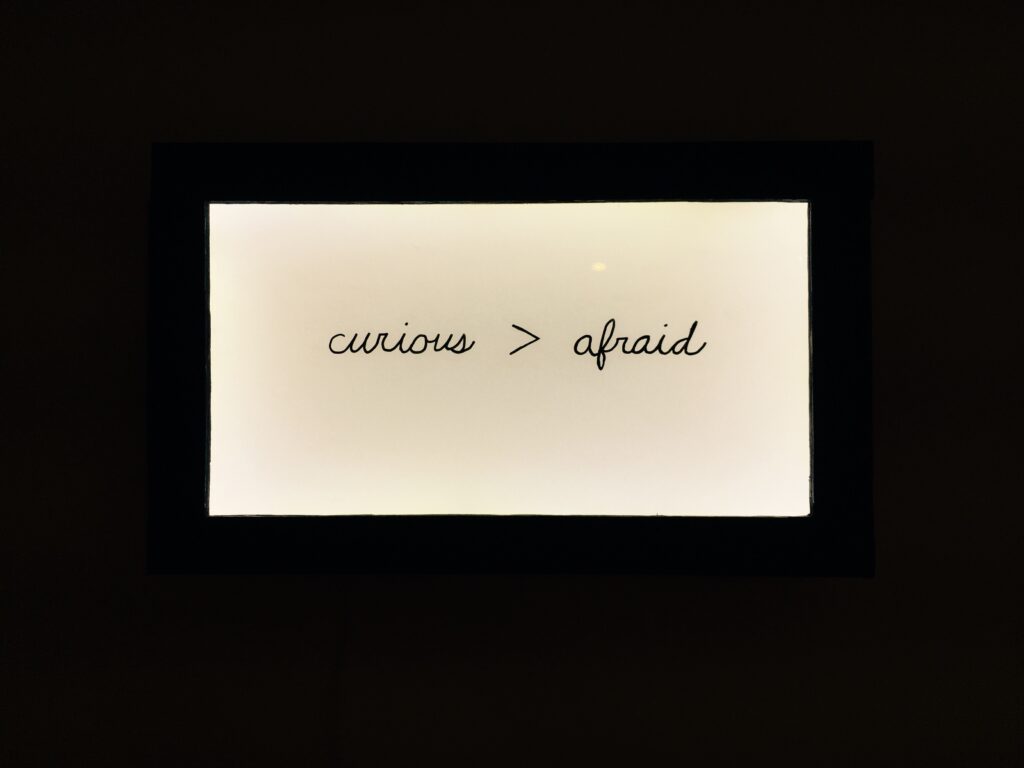
Last month, I attended the 100 Days of Action Inaugural Ball at Royal Nonesuch Gallery in Oakland. The event served as the launch of the 100 Days of Action, a project of artistic resistance, designed to be a counter-narrative to Trump’s plan for his first 100 Days. At the event, guests were prompted to write down their deepest values on a slip of paper and then ring a bell to summon facilitating artist Katina Papson-Rigby to take their slip of paper and place it inside of the Values Vault. Papson-Rigby vowed to collect these values and then contact participants one year later to remind them of the ideas and principles that mattered to them most at this moment in time. The exercise was more challenging than anticipated and prompted me to look inward and ask myself some very important questions: At my core, what do I value most? And why? How are these values reflected in my day-to-day life? How will I continue to uphold these values when they are tested?
More or Less, the new Frank-Ratchye Project Space installation by Root Division studio artist Hunter Franks, provides viewers with a similar opportunity to look inward and consider their own belief systems. Franks, a social practice artist who primarily creates public installation pieces, spoke with me about this new work and the ways in which art can help us consider our own values and inspire us to translate these internal belief systems into concrete actions.
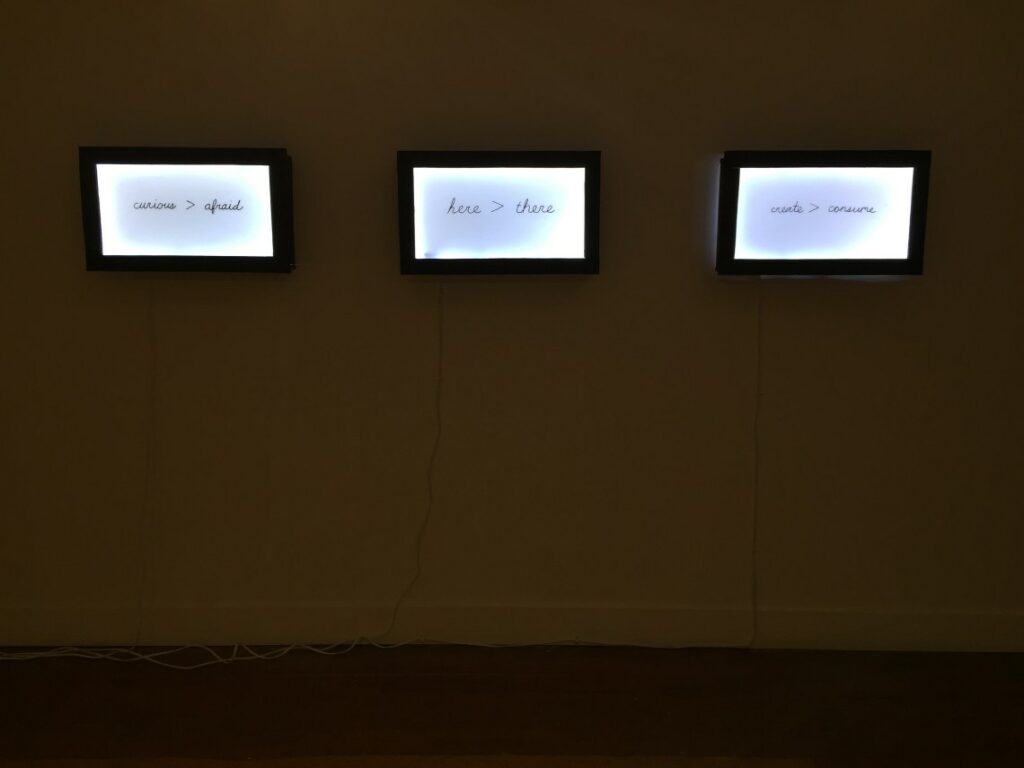
Lauren Etchells: Thanks for taking the time to speak with me, Hunter. Can you tell me more about this new work you made for the project space?
Hunter Franks: This work is a triptych of text-based light sculptures called More Or Less. The pieces compare various emotions, values, and actions and invite the viewer to contemplate the role of each set in their own life. The work is also a suggestion of my own views, stated clearly as “greater than” mathematical equations and omitting the complex process it took for me to arrive at these conclusions. My hope is that the work either sparks a discovery or a rebuttal in the viewer and makes them explore their own inner histories while inspiring future actions.
LE: A lot of your work involves text. How do you choose the words and phrases you use in your work?
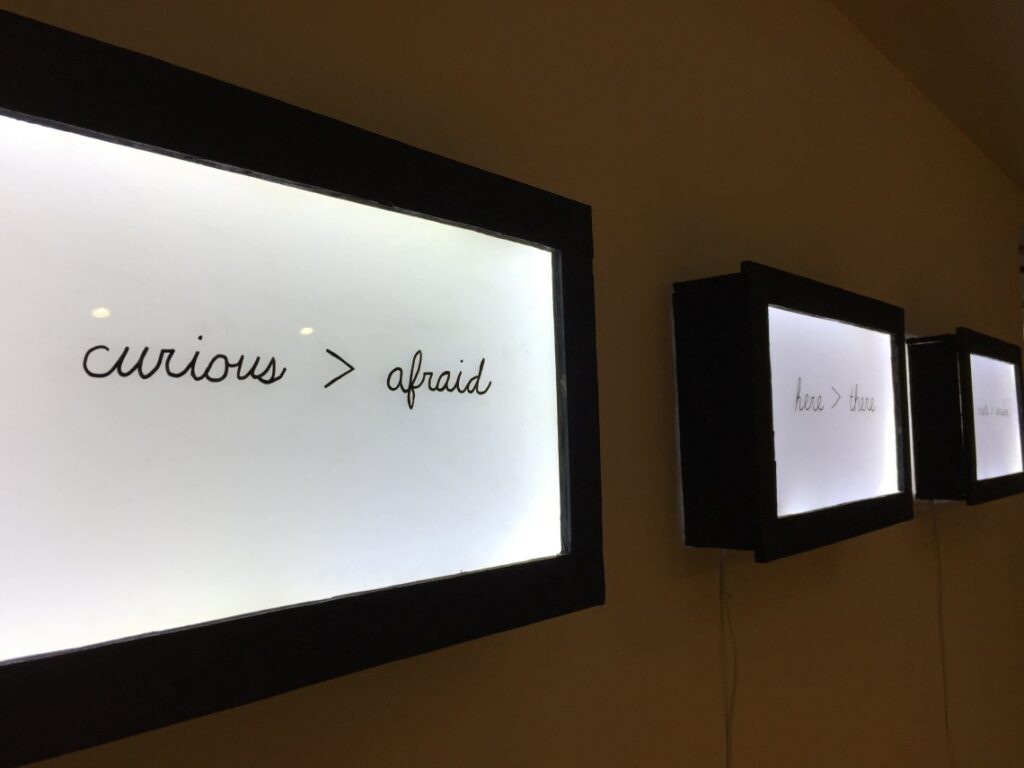
HF: The text in my works comes from all over: overheard conversations on the bus, phrases that strike me in the moment, adaptations of modern tropes, or things that appear in my mind at the quietest of moments. I find text an easily accessible form to work with and one that conveys a message clearly and instantly to the viewer.
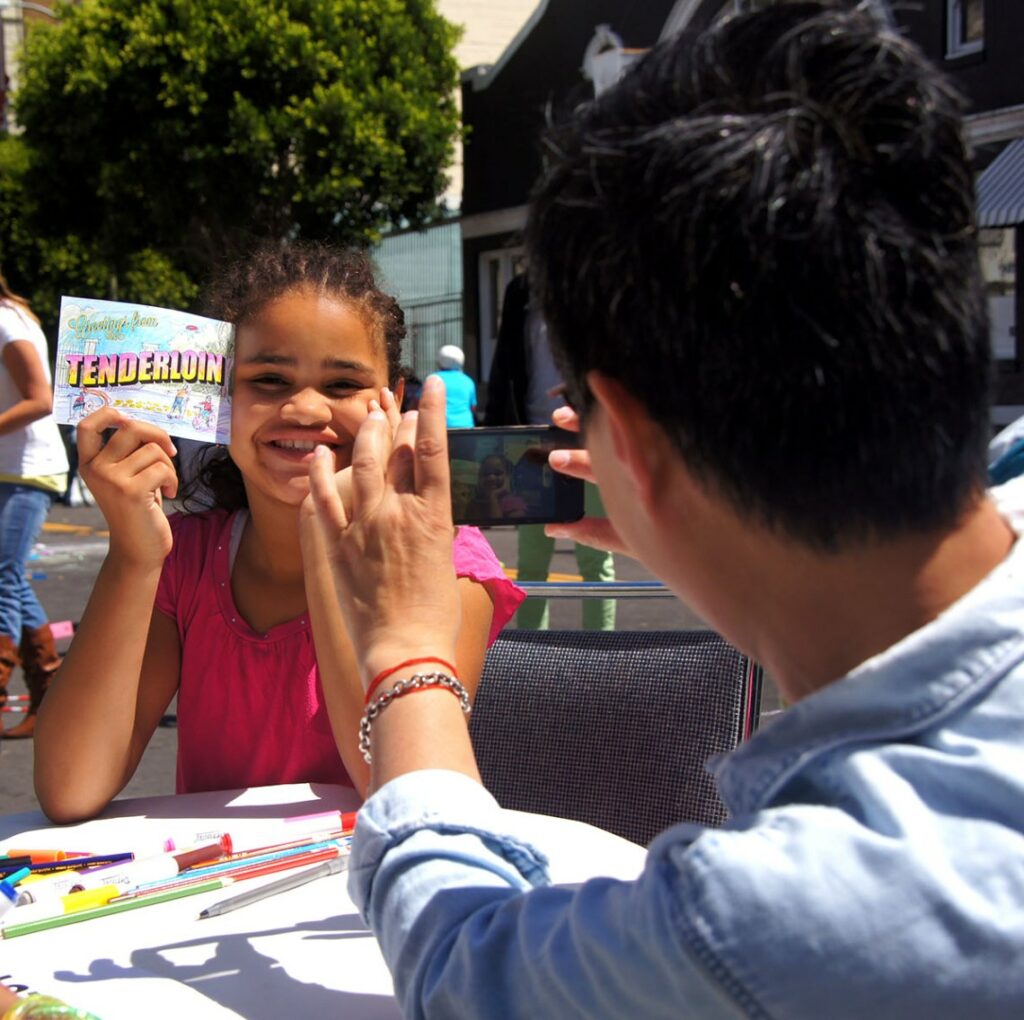
LE: Your work is typically embedded in public places, rather than inside of traditional art spaces. How did you start making public art?
HF: I started making public art because I have a deep interest in how people think and act. Creating work that informs people’s thinking is fitting for public spaces because it is often awash with folks from all different backgrounds. I first became interested in street art in college and that evolved into exploring ideas around making work in public. My senior project in 2008 involved ideas around making the private public. I set up a bedroom and really nice rug in public spaces and filmed how people interacted with the scenes. From there, I didn’t consider social practice art again until I was working at the Mayor’s Office of Civic Innovation in San Francisco in 2013. I had a chance to work with youth in the Bayview neighborhood and they really wanted to change other people’s perception of their neighborhood, which is negatively stereotyped as dangerous and poor. I wanted to help these kids find a way to do that so when I left the Mayor’s Office I developed the Neighborhood Postcard Project, where I collect personal positive stories on postcards from underrepresented neighborhoods and mail them to randomly selected people in different neighborhoods in the same city. The project took off and my social practice work has carried on and evolved since.
LE: Is there a difference for you, showing in public spaces versus inside of a gallery?
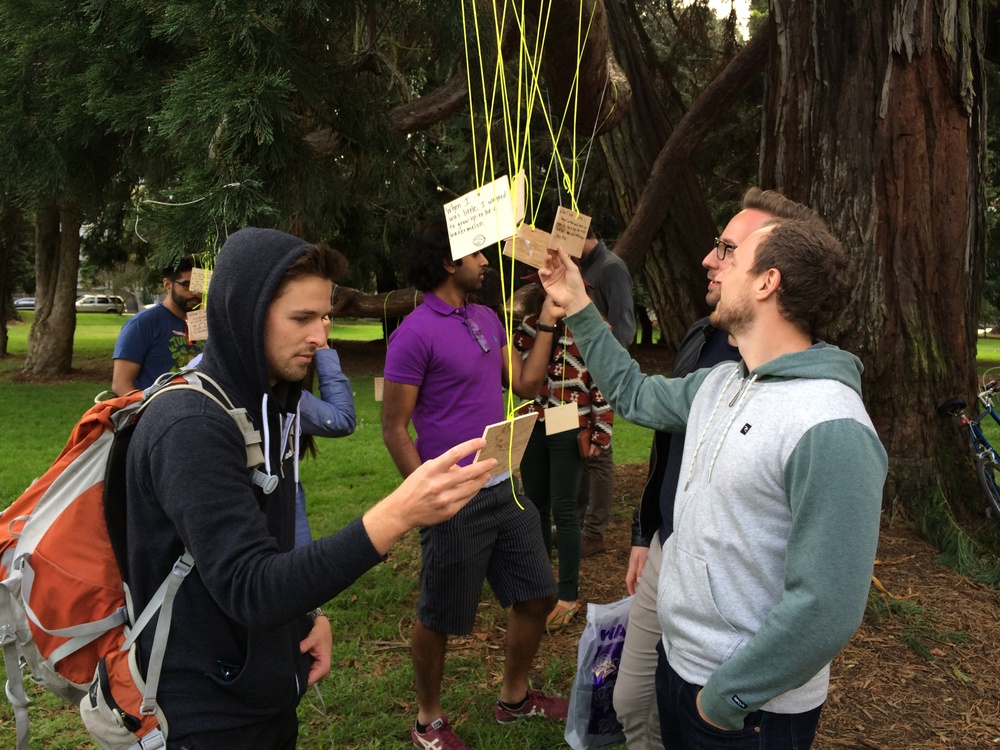
HF: I only recently have begun to show inside of four walls. Much of my public space work is participatory in nature, and I find it more accepted to create work that is simply visual within the gallery environment. It also allows me to play more with ideas that would be harder to execute outdoors, such as light. I think that the audience is the biggest thing that shifts when you move inside a gallery. Only those who intentionally arrive at the space will see the work, as compared to public work which can be a surprise to folks passing by.
LE: What’s your favorite public art project you’ve done?
HF: My favorite public art project I’ve done is 500 Plates, a shared community meal for 500 people on a freeway in Akron, Ohio. The freeway is set to close to automobile traffic and open to development this year, and in 2015 I worked with the City of Akron to reroute traffic for a day and set up a 500 foot long table and invited people to come eat and reimagine the future of the freeway. It was a year long project where we collected one recipe from one person in each of Akron’s 22 neighborhoods and printed those recipes onto ceramic plates which were used at the meal and people could take home. We had guided discussions at the table, and butcher paper that ran the full length of the table that people could share their ideas for the future of the space. Over 150 volunteers helped make it all happen. Food is a wonderful vehicle for cultural exchange, and eating a meal on a freeway was very surreal. The project catalyzed many new connections and sparked civic engagement in folks who may not have previously been involved with a community project.
LE: How important is viewer interaction to your work?
HF: Viewer interaction is at the core of my work, whether that is a physical action that someone takes to participate in the project, or is simply an invitation for the viewer to see the world a bit differently. I always want my work to invoke a reaction or a deepening of inquiry. I think people have much more to share and teach with each other than they realize. Sometimes they just need an invitation to do that.
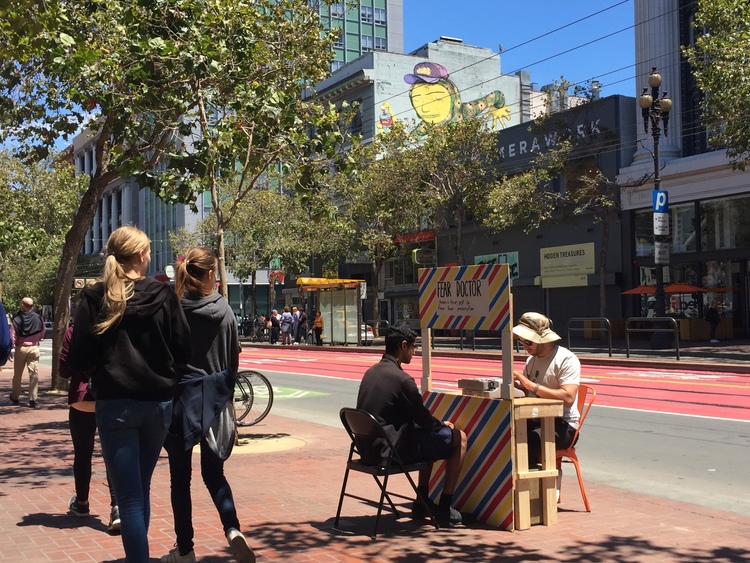
LE: What do you want the viewer to take away from your work?
LE: How do you feel making art in this political climate? What do you feel your role is right now?
HF: I don’t think the role of my work has changed. My work doesn’t seek to divide, but rather to unite. I won’t likely be making work that attacks anything, but rather that invites thinking about our relationships with each other. I strongly believe that the national political climate is a reflection of the relationships we have with each other on a daily basis. If we can’t even say hello to a homeless person on the street, if we operate so greatly out of fear in public, how do we ever expect to have meaningful discussions with the so-called other side? My role is to continue to create work that breaks down fear and allows people to see each other for their inner stories. We are all much more similar than we are different. I hope to continue to show that.
LE: Are there any other artists whose work inspires your own?
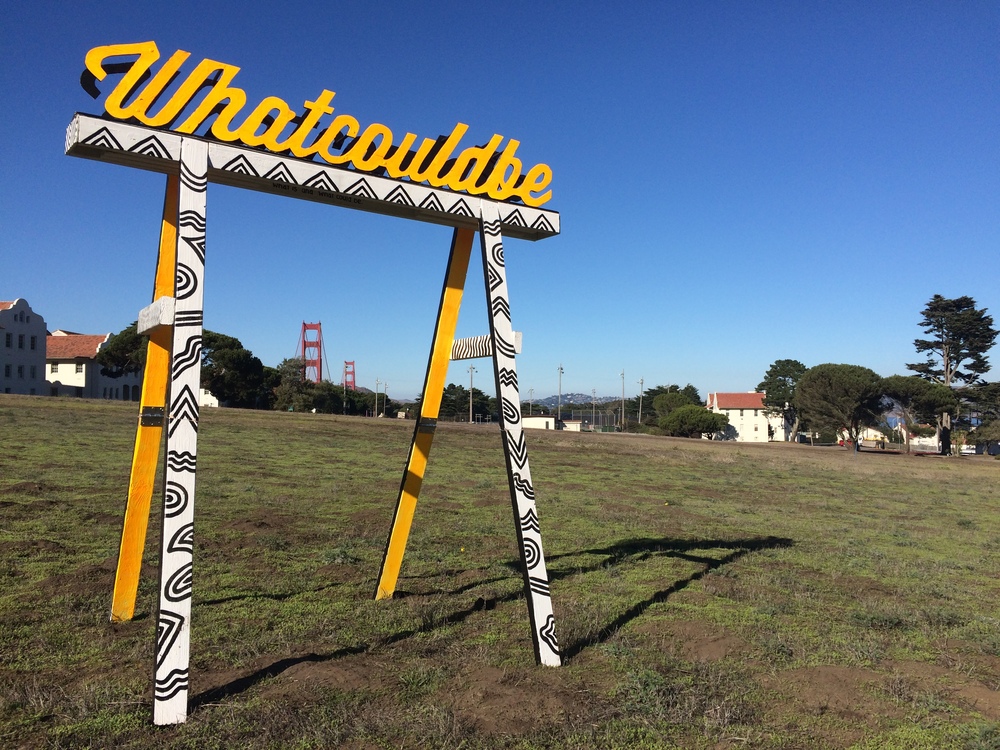
HF: I am inspired by so many artists including Theaster Gates, JR, Candy Chang, Olafur Eliasson, Jenny Holzer, Robert Montgomery.
LE: What has it been like having a studio here at Root Division?
HF: Having a studio at Root Division is wonderful. Being a part of a group of artists that supports each other and gives back to the community is very special.
LE: Thanks for taking the time to answer my questions, Hunter, and congratulations on this beautiful new work.
Check out More or Less in the Frank-Ratchye Project Space at Root Division’s 2nd Saturday series event this Saturday, February 11.
This Saturday’s event also features a special performance by jazz trio Broun Fellinis, presented in conjunction with the Museum of African Diaspora’s exhibition Where is Here?
Hunter Franks, More or Less will be on view from February 8 – 24, 2017. Gallery Hours: Weds-Sat 2- 6pm (or by appt.)
